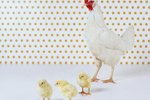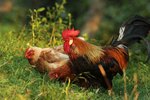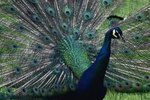
The common saying among chicken experts is "if it crows, it's a rooster; if it lays an egg, it's a hen," easily identifies hens and roosters. But sometimes birds are too young to crow or lay eggs. When that happens, you must look at the bird for clues.
Feathers
Roosters often have distinguishing hackle or neck feathers and saddle or back feathers. In roosters, these feathers are often pointed, whereas on hens, these feathers are rounded. If there is more than one rooster in the group, they will often square off and their hackle feathers will puff out as a stare at each other. Rooster tail feathers have a curve to them. Because of their shape, they are often called "sickle feathers."
Legs
Roosters often have thicker legs than hens and have pointed, sharp spurs. The rooster uses these spurs to protect the flock and defend himself. They are sharp, bone-like growths just above the toes on the rooster's leg. Old hens will sometimes have spurs, but they will not be as long or sharp as those on roosters.
Wattles and Combs
Roosters usually have tall, upright and larger combs than hens. If the rooster is young, he will have a more pronounced comb than female chicks of the same age. Roosters tend to have redder combs and wattles at an earlier age than those chicks of the same age. When mature, rooster wattles are very large when compared to hen's.
Coloring
Roosters often have showier plumage than hens. Their colors are often bright and vibrant. Many roosters have iridescent feathers that capture the light and show off beautiful blue and green highlights. If the bird has iridescent plumage, it is most likely a rooster.
References
- Raising Chickens for Dummies; Kimberly Willis and Rob Ludlow, pp 223-227
- My Pet Chicken; At What Age Does a Rooster Begin Crowing?
- SageHenFarmLodi.com; Sexing Chicks After a Few Weeks
Photo Credits
-
Jupiterimages/Photos.com/Getty Images




